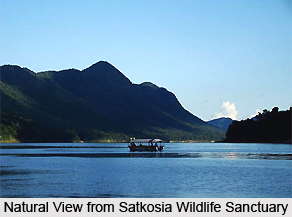 Satkosia Basipalli Sanctuary is enlisted among the most famous and significant wildlife sanctuaries of the state of Orissa. It is also known as Satkosia Tiger Reserve according to its recent renaming. Established in the year 1976, it is situated over a magnificent gorge over the Mahanadi River.
Satkosia Basipalli Sanctuary is enlisted among the most famous and significant wildlife sanctuaries of the state of Orissa. It is also known as Satkosia Tiger Reserve according to its recent renaming. Established in the year 1976, it is situated over a magnificent gorge over the Mahanadi River.
Satkosia Basipalli Sanctuary is spread over an area of 1330 square kilometres and is divided into two parts by the river. The districts of Angul, Budh, Cuttack and Nayagarh share the area of the sanctuary. It has gained a great fame owing to its Gharial Breeding Project. Satkosia Basipalli Sanctuary is also a paradise for nature, wildlife and adventure lovers. In Angul subdivision, the region has moist and dry deciduous forests, dense groves, hills and flowers with bright and vivid colours like Genwa and Khalsi.
Satkosia Wildlife Sanctuary is home to a huge variety of wildlife including leopards, Royal Bengal tigers, elephant, mouse deer, nilgai, gaur, sloth bears, wild goats, spotted deer, sambhar, our-horned antelopes, giant squirrels, varied species of snakes and many more. Apart from this, the aquatic life of the sanctuary includes Indian Crocodile s, also known as gharials, mugger crocodiles and fresh water turtles. Gharial Research and Conservation Unit of this sanctuary is located in Tikarapada.
About 269 square kilometres area of the sanctuary is allowed to be accessed by the tourists. Baghmunda is the region where tigers reside and is a prominent tourist attraction. Splendid view of groups of elephants can be seen in three corridors namely Satkosia-Khalasuni corridor, Kapilas-Rebena corridor and Athamallik-Chhendipada-Telkoi corridor. Among the nearby places of Satkosia Wildlife Sanctuary Tikarpara is famous for its gorgeous view and gracefully flowing river. Labangi, located atop a hill, is another beautiful place. Purnakot is known for hiking, Hati Girga is renowned for its watch tower and Kandhaid is famed for dense forests. Tourist sites hosting exquisite waterfalls and streams are Bheemdara and Sitalpaani. Apart from exploring the wonders of nature, certain adventurous activities can also be enjoyed in this region like elephant rides, trekking, boating and night safaris, arranged by the Forest Department.
Tourism in Satkosia Basipalli Sanctuary is allowed between the months of October and February. However, the ideal time to visit this sanctuary is in the months of December and January. Tourists visiting this sanctuary can find accommodation inside the sanctuary area as well as around it in various guest houses.











